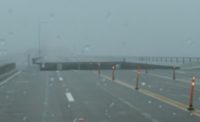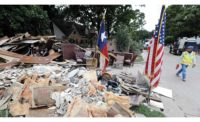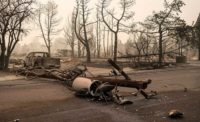Modular Bridge to Reconnect Communities in Puerto Rico

Six months after Hurricane Maria hit Puerto Rico on Sept. 20, landslides, broken traffic lights and reconstruction traffic make Edgar Iñesta’s commute halfway across the 100-mile-wide island a slow crawl.
PHOTO BY SCOTT BLAIR FOR ENR
Six months after Hurricane Maria hit Puerto Rico on Sept. 20, landslides, broken traffic lights and reconstruction traffic make Edgar Iñesta’s commute halfway across the 100-mile-wide island a slow crawl. It takes him five hours to make the round trip to Morovis, where he serves as project manager on a new bridge being built across the Manati River.
Iñesta is hardly alone. Of the 30 men at Del Valle Group working to replace the reinforced concrete bridge that was washed 300 ft downriver by the swollen river, several would normally have used the bridge in their daily commute, Iñesta says. Now, they, like the residents of Morovis, must either take treacherous hairpin-turn roads through the mountains to get to the site or ford the river.
In the days after Hurricane Maria, desperate residents walked across the river, carrying the sick residents of Morovis on their backs to hospitals.
It’s not simply the work that keeps the workers coming every morning. A sense of purpose and drive to restore the tropical paradise for its 3.4 million people may be the biggest motivator.
“This is a way to build back, but better,” says Carmelo Calderón, Del Valle vice president. “The community really appreciates our efforts here.” So much so that local residents have prepared lunch for the crew each day they’ve been on site since early January, he adds.
The $4.7 million bridge is built 1 ft above the river's 200-year-flood level and is built to withstand floodwaters. Del Valle President Humberto Reynolds says he took stock of what materials were on hand and told the designer to use those materials. In the days and weeks after the storm, lack of power stilled the production of aggregate and asphalt.
Though the bridge is considered a temporary structure by U.S. Department of Transportation, which took charge of the damaged local bridges and roads, it is built to last. The 8-meter-wide, three-span modular steel bridge, manufactured in Ohio by U.S. Bridge, was shipped in 17 containers to the site and assembled atop 40-ft-deep drilled shaft foundations using two cranes.
The trusses were aligned using digital surveying and workers had to check and double check the alignment before putting the sections together. "It was a challenge," Iñesta says. "There was no way of going back."
Employing design-build delivery, Del Valle changed the original foundation design to help speed construction, allowing the bridge to open in early April, Calderón says.
“The collaborative effort from, the contractors, the U.S. Government, and the people of Puerto Rico, has made this an extremely fulfilling project," said Todd Carpenter, bridge superintendent at U.S. Bridge, which built the Manati bridge and three others for the territory. "Knowing that our bridges are being used for connecting communities that were shattered, is something I’ll never forget. And these communities will use these bridges for generations to come.”
By Pam Radtke Russell and Scott Blair
Related Article: Six Months Later, Puerto Rico Recovery Inches On





